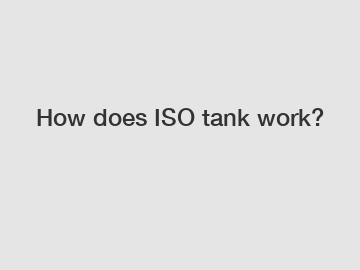How does ISO tank work?
ISO tanks, also known as intermodal tanks, are essential for transporting liquids and gases safely and efficiently around the world. These tanks are designed to be used with various modes of transportation, including ships, trucks, and trains. But how exactly do ISO tanks work? In this article, we will explore the inner workings of ISO tanks and how they facilitate the movement of liquids and gases across long distances.
### Construction of ISO Tanks.
ISO tanks are typically constructed from stainless steel or carbon steel to ensure durability and resistance to corrosion. They have a cylindrical shape with a capacity ranging from 14,000 to 26,000 liters, making them suitable for transporting a wide range of liquids and gases. The tanks are equipped with safety features such as pressure relief valves, emergency shutoff valves, and spill containment systems to prevent accidents during transportation.

### Loading and Unloading.
Before loading the liquid or gas into the ISO tank, it undergoes a thorough cleaning and inspection process to ensure that it meets safety standards. The tank is then filled with the liquid or gas using a pump or gravity feed system. Once the tank reaches its destination, the liquid or gas is unloaded using the same process in reverse. The tanks are designed to be easily connected and disconnected from loading and unloading facilities, allowing for quick and efficient transfer of materials.
### Transportation.
ISO tanks are versatile in terms of transportation, as they can be easily moved from one mode of transportation to another. For example, a tank filled with chemicals can be transported by truck to a port, where it is loaded onto a ship for overseas transportation. The tanks are designed to fit securely onto trucks, trains, and ships, ensuring that the contents remain stable and secure during transit. This flexibility makes ISO tanks a popular choice for companies looking to transport liquids and gases over long distances.
### Heating and Cooling Systems.
Some liquids and gases require specific temperatures to maintain their properties during transportation. ISO tanks are equipped with heating and cooling systems that allow operators to regulate the temperature inside the tank. For example, tanks used for transporting food-grade products like chocolate or edible oils may be equipped with heating coils to keep the contents at a certain temperature. Similarly, tanks used for transporting liquefied gases may have a refrigeration unit to keep the contents from evaporating.
### Safety Regulations.
ISO tanks are subject to strict safety regulations to ensure the protection of the environment and the safety of workers and the general public. These regulations cover every aspect of ISO tank operation, from design and construction to loading, transportation, and unloading. Tank operators must undergo regular training to ensure they are equipped to handle any emergency situations that may arise during transportation. By following these regulations, ISO tank operators can ensure the safe and secure movement of liquids and gases across long distances.
In conclusion, ISO tanks play a crucial role in the global supply chain by facilitating the transportation of liquids and gases in a safe and efficient manner. The tanks are built to withstand the rigors of transportation and are equipped with safety features to prevent accidents and spills. With their versatility and flexibility, ISO tanks have become a preferred choice for companies looking to transport materials over long distances. Contact us to learn more about how ISO tanks can meet your transportation needs.
The company is the world’s best Miniature Bulk Tank For Liquid Gas, Low Temperature Liquid Carbon Dioxide Micro Bulk Storage Tank, Lox Cryogenic Storage Tank supplier. We are your one-stop shop for all needs. Our staff are highly-specialized and will help you find the product you need.
89
0
0


Comments
All Comments (0)